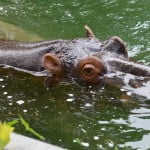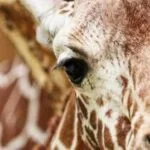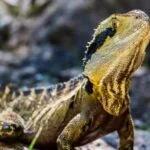The Non-Elephant in the Room – Why Don‘t We Care About All Animals Equally?
There’s a big elephant in the room, but it’s not an elephant, and that’s the problem. When we talk about the welfare of an animal, it’s easier to comprehend when we think about big charismatic species like bears, tigers, or elephants. But there is an increasing amount of research looking into the capacity of other species to experience emotions such as curiosity and suffering.

Image © David Achilles
When asked to think of a random animal, most of us might immediately jump to a mammal. Perhaps you think of your pet dog sleeping soundly by your side, or perhaps their ancestor the wolf roaming the woods in some wild and mountainous place. We instinctively connect with species which hold similarities to ourselves, making other species of primate an obvious choice.
In several studies exploring the popularity of particular species among the human population, the tiger reigned supreme, alongside other mammalian species such as dolphins, gorillas and more recently, hippos. This is probably in large part thanks to the viral sensation of Moo Deng.
The problem is that the under-appreciated animals who sadly get significantly less of the limelight, also have conservation concerns and welfare needs. But do people really care how a snake feels? Is anyone interested in the well-being of a frog? Are people as concerned over the critical conservation status of a cockroach as they are over a capuchin? Sure these taxonomic groups have a few champions out there in the world but the majority of the funding, fame and favouritism tends to go to a very small percentage of the total species that roam this planet.
 If we as humans put less emphasis on these species, does that mean that their welfare needs are any different? The science seems to suggest not. There is an increasing number of studies exploring topics such as pain perception in fish and crustaceans, sentience in amphibians and even environmental preferences in invertebrates. This research shows an expanding understanding into the importance of considering the needs of any and all species, no matter the public perception of them. It’s encouraging to see this data being developed but the dissemination of it is another important factor. How long will it be until this information manages to trickle down to animal caregivers and facilities, becoming implemented action rather than theoretical knowledge?
If we as humans put less emphasis on these species, does that mean that their welfare needs are any different? The science seems to suggest not. There is an increasing number of studies exploring topics such as pain perception in fish and crustaceans, sentience in amphibians and even environmental preferences in invertebrates. This research shows an expanding understanding into the importance of considering the needs of any and all species, no matter the public perception of them. It’s encouraging to see this data being developed but the dissemination of it is another important factor. How long will it be until this information manages to trickle down to animal caregivers and facilities, becoming implemented action rather than theoretical knowledge?
These innate biases which humans have can also impact our understanding of what good care or welfare might look like for different species. An example of this can be seen in our concern reporting system. In the past we’ve had people reaching out having visited a facility primarily housing non-mammals but only reporting on the few mammals housed there. In some cases people have openly admitted that they have no idea what good care and welfare looks like for birds, amphibians, reptiles or fish, so they couldn’t comment on that specifically.

Chart showing the number of concern reports made to Wild Welfare in the past five years based on species type. The majority are mammals.
Through our online welfare concern reporting system, we have received hundreds of concerns regarding mammals over the years, with the vast majority being elephants, big cats, monkeys and bears. In comparison, the reports sent in regarding any other non-mammal species are significantly less, and tend to focus on either parrots or crocodiles.
The same goes for our news updates and social media posts, which will all reliably get much more engagement with a charismatic mammal as the hero of the story. Media attention is always given to emotive animal rescue stories centring around larger mammals, despite the possibility of many other smaller and less appreciated animals still housed and potentially suffering at that same facility.
 It is far harder to empathise with an earwig than an elephant, but that is why the evidence highlighting the emotional capabilities of these less-favoured creatures is so important. When we look at the leaps forward in animal welfare knowledge and understanding over the past 30 years, it’s much easier to apply to those we have a higher affinity with, but that is our failing rather than the animals we might seek to understand.
It is far harder to empathise with an earwig than an elephant, but that is why the evidence highlighting the emotional capabilities of these less-favoured creatures is so important. When we look at the leaps forward in animal welfare knowledge and understanding over the past 30 years, it’s much easier to apply to those we have a higher affinity with, but that is our failing rather than the animals we might seek to understand.
So the next time you think about animals, their conservation and their welfare, remember that mammals are only a tiny proportion of the world’s species, and there are so many more fascinating and under-appreciated animals you might not have even heard of yet. They all deserve the attention and admiration of the world, and they all have specific welfare needs, no matter what they look like, or whether we have a particular fondness for them or not.

Wild Welfare is devoted to improving the welfare of captive animals across the world. You can support our efforts by sharing this article, signing up to our newsletter, following our social media accounts (Facebook, Instagram and X), or by making an online donation. Every small contribution can help us to develop our vital accessible animal resources. Thank you.
The views, opinions and positions expressed by our bloggers are theirs alone, and do not necessarily reflect the opinions of Wild Welfare or any employee thereof. Wild Welfare is not responsible for the accuracy of any of the information supplied by the guest bloggers. We accept no liability for any errors, omissions or representations. The copyright of this content (including images) belongs to the author and any liability with regard to infringement of intellectual property rights remains with them.





